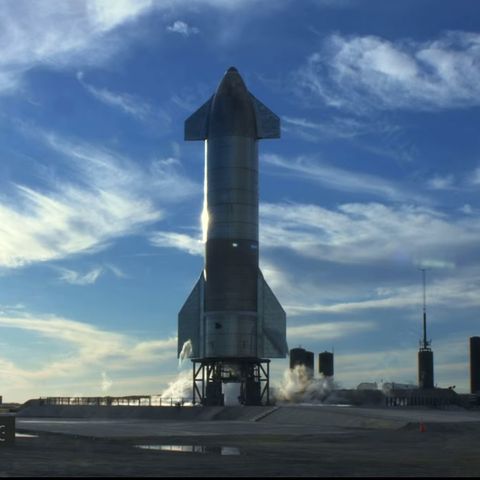UFO Buster Radio News – 440: SN8 Auto-Abort, Chang'e 5 Has Got the Scoop, Farewell Chuck, and Ryugu Sample At Australian Lab

Sign up for free
Listen to this episode and many more. Enjoy the best podcasts on Spreaker!
Download and listen anywhere
Download your favorite episodes and enjoy them, wherever you are! Sign up or log in now to access offline listening.
Chapters
Description
New Podcast Locations starting 01/01/2021 The NEW Dark Horde - https://thedarkhorde.podbean.com/ The Tempest Universe - https://thetempestuniverse.podbean.com/ Join the Episode after party on Discord! Link: https://discord.gg/ZzJSrGP SpaceX aborts Starship SN8 prototype...
show moreThe NEW Dark Horde - https://thedarkhorde.podbean.com/
The Tempest Universe - https://thetempestuniverse.podbean.com/
Join the Episode after party on Discord!
Link: https://discord.gg/ZzJSrGP
SpaceX aborts Starship SN8 prototype test launch at last second
Link: https://www.space.com/spacex-starship-sn8-launch-abort
We'll have to wait a little longer to see SpaceX's latest Starship prototype make its highly anticipated big hop. The vehicle, known as Starship SN8 ("Serial No. 8"), was scheduled to launch on an 8-mile-high (12.5 kilometers) test flight today (Dec. 8) from SpaceX's South Texas facility, near the Gulf Coast village of Boca Chica.
And it nearly happened. But less than 2 seconds before liftoff, just after 5:30 p.m. EDT (2230 GMT and 4:30 p.m. local Texas time), SN8 detected something abnormal with one or more of its three Raptor engines and automatically aborted the flight.
It's unclear at the moment when SN8 will get its next chance to fly; that depends on what caused the abort and how difficult it will be to fix. But there are launch windows available on both Wednesday and Thursday (Dec. 9 and Dec. 10), SpaceX representatives said.
NASA's spacecraft spots China's Chang'e 5 lander on the moon
Link: https://www.space.com/change-5-moon-lander-photo-lunar-reconnaissance-orbiter
NASA's Lunar Reconnaissance Orbiter captured an image of China's Chang'e 5 lander on the moon just hours after its historic landing.
The Chang'e 5 lander set down on the lunar surface last Tuesday, Dec. 1. Thanks to China's prompt release of the stunning Chang'e 5 landing video, the Lunar Reconnaissance Orbiter Camera (LROC) team were able to locate the roughly 4-ton spacecraft in Oceanus Procellarum, the "Ocean of Storms," and prepare for when LRO would pass overhead the next day.
The image shows the Chang'e 5 lander in the center of three craters. Automated systems had helped the spacecraft avoid these hazards to land safely.
The image was taken before the Chang'e 5 ascent vehicle blasted off from the surface with the collected samples. The ascent vehicle has since performed a spectacular rendezvous and docking with the Chang'e 5 orbiter and handed over the samples. Chang'e 5 will begin its journey to Earth later this week.
Chuck Yeager, 1st pilot to break the sound barrier, is dead at 97
Link: https://www.space.com/chuck-yeager-first-pilot-to-break-sound-barrier-dead
Chuck Yeager, the U.S. Air Force Pilot who became the first person to break the sound barrier, died Monday (Dec. 7) at the age of 97.
Yeager's wife, Victoria, shared the news on Twitter, writing: "It is w/ profound sorrow, I must tell you that my life love General Chuck Yeager passed just before 9pm ET. An incredible life well lived, America's greatest Pilot, & a legacy of strength, adventure, & patriotism will be remembered forever."
Yeager became the first person to break the sound barrier on Oct. 14, 1947, while flying the Bell X-1 rocket plane 45,000 feet (13,700 meters) over the Rogers Dry Lake in the Mojave Desert. During the flight, Yeager reached Mach 1.05, or 1.05 times the speed of sound. The aircraft, which he dubbed Glamorous Glennis after his first wife Glennis Yeager, who died in 1990. The Bell X-1 now hangs on display in the Smithsonian Air and Space Museum in Washington.
Yeager would go on to fly even faster aircraft, including the Lockheed XF-104, which flew more than twice the speed of sound. His daring test flights were featured in Tom Wolfe's 1979 book "The Right Stuff" as well as the film adaptation and new Disney Plus series by the same name.
EXPLAINER: What has Japanese space mission accomplished?
Link: https://apnews.com/article/japan-space-mission-accomplish-explained-88e9a90bca3971bfe864aa94c01de7d4
A small capsule containing asteroid soil samples that was dropped from 136,700 miles (220,000 kilometers) in space by Japan’s Hayabusa2 spacecraft landed as planned in the Australian Outback on Sunday. After a preliminary inspection, it will be flown to Japan for research. The extremely high precision required to carry out the mission thrilled many in Japan, who said they took pride in its success. The project’s manager, Yuichi Tsuda of the Japan Aerospace Exploration Agency, called the capsule a “treasure box.”
Launched on Dec. 3, 2014, the unmanned Hayabusa2 spacecraft touched down twice on the asteroid Ryugu, more than 300 million kilometers (190 million miles) away from Earth. The asteroid’s extremely rocky surface forced the mission’s team to revise landing plans, but the spacecraft successfully collected data and soil samples during the 1½ years it spent near Ryugu after arriving there in June 2018.
The pan-shaped capsule, about 40 centimeters (15 inches) in diameter, contains soil samples taken from two different sites on the asteroid. Some gases might also be embedded in the samples. The preliminary inspection at a lab in Australia was to extract and analyze the gas. The capsule is due to return to Japan on Tuesday. It will be taken to JAXA’s research center in Sagamihara, near Tokyo.
Scientists say the samples, especially ones taken from under the asteroid’s surface, contain data from 4.6 billion years ago unaffected by space radiation and other environmental factors. They are particularly interested in studying organic materials in the samples to learn about how they are distributed in the solar system and if or how they are related to life on Earth.
WHAT’S NEXT?
About an hour after separating from the capsule at 220,000 kilometers (136,700 miles) from Earth, Hayabusa2 was sent on another mission to the smaller asteroid, 1998KY26. That is an 11-year journey one-way. The mission is to study possible ways to prevent big meteorites from colliding with Earth.
Podcast Stuff
Podbean: The Dark Horde - https://thedarkhorde.podbean.com/
Podbean: The Tempest Universe - https://thetempestuniverse.podbean.com/
Facebook: The Dark Horde - https://www.facebook.com/thedarkhordellc
Facebook: The Tempest Universe - https://www.facebook.com/thetempestuniverse
Facebook: Manny’s Page - https://www.facebook.com/MannyPodcast
Twitter: The Tempest Universe - https://twitter.com/ufobusterradio
Twitter: The Dark Horde - https://twitter.com/HordeDark
Discord Group - https://discord.com/channels/679454064890871869/679454064890871875
Mail can be sent to:
The Dark Horde LLC
PO BOX 769905
San Antonio TX 78245
Comments

Greenman
3 years ago

Andre Ortiz
3 years ago

GameVet02
3 years ago

Greenman
3 years ago

Andre Ortiz
3 years ago

Greenman
3 years ago

Andre Ortiz
3 years ago

Greenman
3 years ago

Greenman
3 years ago

Greenman
3 years ago

Greenman
3 years ago

Andre Ortiz
3 years ago

Andre Ortiz
3 years ago

Greenman
3 years ago

Andre Ortiz
3 years ago

Greenman
3 years ago

Greenman
3 years ago

Andre Ortiz
3 years ago

Andre Ortiz
3 years ago

Andre Ortiz
3 years ago

Greenman
3 years ago

Andre Ortiz
3 years ago

Greenman
3 years ago

Andre Ortiz
3 years ago

Greenman
3 years ago
Information
| Author | The Dark Horde Network |
| Organization | The Dark Horde Network |
| Website | - |
| Tags |
Copyright 2024 - Spreaker Inc. an iHeartMedia Company
